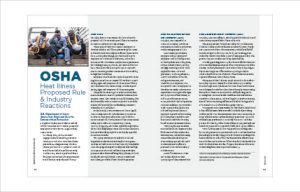OSHA Heat Illness Rule & Industry Reactions
U.S. Department of Labor Announces Proposed Rule for Extreme Heat Protection
As reported in the June Insulation Outlook article “Heat Illness Prevention: 5 Steps for Employers to Take” by NIA Legal Counsel Gary Auman:
“As of May 2024, OSHA remained engaged in the rulemaking process to develop a standard to cover heat illness prevention. Acting Secretary of Labor Julie Su predicted that a proposed standard would be available for public review by October 2024. She also predicted that a final standard on heat illness prevention would be in place by the end of 2024.”
From OSHA:
On July 2, the U.S. Department of Labor released a proposed rule for Heat Injury and Illness Prevention in Outdoor and Indoor Work Settings.
The proposed rule would require employers to develop an injury and illness prevention plan to control heat hazards in workplaces affected by excessive heat. Among other things, the rule would require employers to evaluate heat risks and—when heat increases risks to workers—implement requirements for drinking water, rest breaks, and control of indoor heat. The rule would also require a plan to protect new or returning workers unaccustomed to working in high heat conditions.
Employers would also be required to provide training, have procedures to respond if a worker is experiencing signs and symptoms of a heat-related illness, and take immediate action to help a worker experiencing signs and symptoms of a heat emergency.
The public is encouraged to submit written comments on the rule once it is published in the Federal Register. OSHA also anticipates a public hearing after the close of the written comment period. More information will be available on submitting comments when the rule is published.
In the interim, OSHA continues to direct significant existing outreach and enforcement resources to educate employers and workers, and hold businesses accountable for violations of the Occupational Safety and Health Act’s General Duty Clause, 29 U.S.C. § 654(a)(1), and other applicable regulations. Record-breaking temperatures across the nation have increased the risks people face on the job, especially in summer months.
The agency continues to conduct heat-related inspections under its National Emphasis Program—Outdoor and Indoor Heat-Related Hazards, launched in 2022. The program inspects workplaces with the highest exposures to heat-related hazards proactively to prevent workers from suffering injury, illness, or death needlessly. Since the launch, OSHA has conducted more than 5,000 federal heat-related inspections.
From the Associated Builders and Contractors (ABC):
On July 2, ABC responded to OSHA’s Heat Injury and Illness Prevention in Outdoor and Indoor Work Settings proposed rule.
“ABC continues to believe employers should equip their employees and leadership teams to develop their own safety plans, unique to their jobsites, and we strongly encourage review of all applicable OSHA rules and guidelines,” said Greg Sizemore, ABC Vice President of Health, Safety, Environment, and Workforce Development. “We also provide tools to employers so that they can equip and empower supervisors to recognize the signs and symptoms of heat illness, as well as provide necessary rest, water, and shade that is dependent on local conditions. Our members work to ensure that jobsites are safe and implement the most appropriate practices for working in extreme heat conditions that focus on the individual worker, based on CDC recommendations.
“However, those protections must be flexible in response to the fluid nature of the construction environment, and unfortunately, some of the unworkable provisions in the proposed rule could weaken contractor efforts to prevent heat stress for workers,” said Sizemore.
ABC will continue to review and analyze the more than 1,000 pages of the proposed rule.
From Associated General Contractors (AGC):
On July 2, AGC CEO Jeffrey D. Shoaf responded to the release of OSHA’s new proposed federal heat safety rule.
“The proposed new federal heat safety rule codifies many of the heat safety practices the construction industry already uses to protect workers. Those measures, which broadly fall into the categories of water, rest, shade, and training, were crafted by construction firms as part of their general duty obligations to protect workers and keep them healthy.
“It is disappointing, however, that federal officials have not addressed the disparate impacts of heat in various parts of the country. In short, the impacts on worker safety of a 90-degree day in Mississippi are different than a 90-degree day in Alaska. The final version of the rule should take into account regional differences in weather patterns.
“The proposal also lacks any emphasis on the role workers must play to protect themselves from the heat. Heat safety does not begin at the job site and the rule should include measures designed to reinforce the role workers play in protecting themselves. These measures include self-hydrating, understanding how common health conditions and medications contribute to heat stress, and avoiding the excessive consumption of drinks containing caffeine and alcohol during periods of extreme heat. All of which the agency is aware.
“We appreciate the opportunities we have had to help federal safety officials learn about successful methods of protecting workers on job sites. That communication is one reason why so many of the measures outlined in the proposed new rule track with industry practices that are already in use. We are in the process of reviewing all the details of the new proposal with our members to ensure we can provide feedback to agency officials.
“Overall, this proposed new rule provides a starting point for creating measures to protect workers that are based on what the industry is already doing. We look forward to working with federal officials to craft a final rule that includes effective measures for firms and workers to follow. That final rule should also avoid the kind of one-size-fits-all approaches that will do more to hamstring firms than to protect workers.”
Visit www.osha.gov/heat for heat illness prevention resources and more information. Developments on the proposed rule will appear in future NIA communications.

